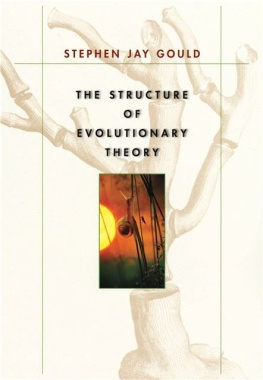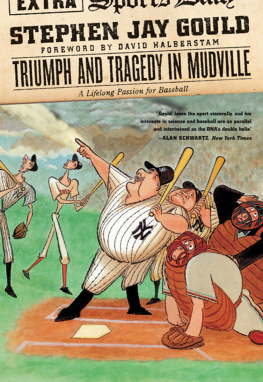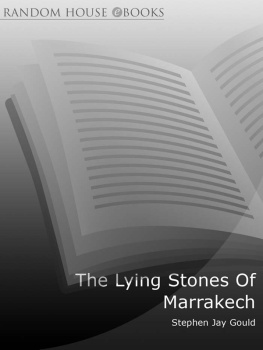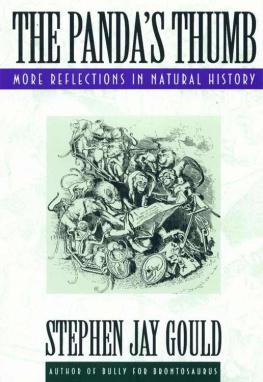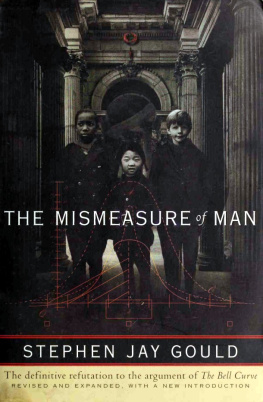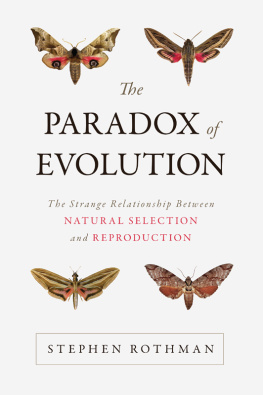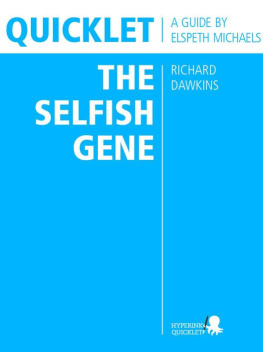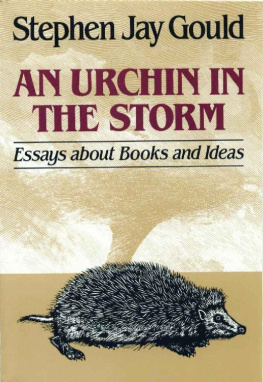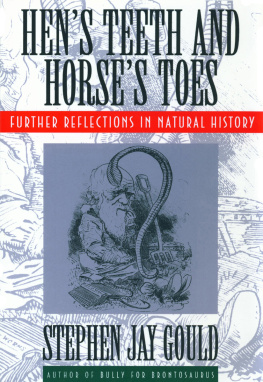Footnotes
* Two of these three ranked as folk wisdom in Darwin's day and needed no further justification variation and inheritance (the mechanism of inheritance remained unknown, but its factuality could scarcely be doubted). Only the principle that all organisms produce more offspring than can possibly survive superfecundity, in Darwin's lovely term ran counter to popular assumptions about nature's benevolence, and required Darwin's specific defense in the Origin.
* As so much unnecessary rancor has been generated by simple verbal confusion among different meanings of this word, and not by meaningful conceptual disagreements, I should be clear that I intend only the purely descriptive definition when I write macroevolution that is, a designation of evolutionary phenomenology from the origin of species on up, in contrast with evolutionary change within populations of a single species. In so doing, I follow Goldschmidt's own definitional preferences (1940) in the book that established his apostasy within the Modern Synthesis. Misunderstanding has arisen because, to some, the world macroevolution has implied a theoretical claim for distinct causes, particularly for nonstandard genetic mechanisms, that conflict with, or do not occur at, the microevolutionary level. But Goldschmidt and I follow him here urged a nonconfrontational definition that could stand as a neutral descriptor for a set of results that would then permit evolutionists to pose the tough question without prejudice: does macroevolutionary phenomenology demand unique macroevolutionary mechanics? Thus, in this book, macroevolution is descriptive higher-level phenomenology, not pugnacious anti-Darwinian interpretation.
* I base this chapter on an exploration of the logic of argument in the first edition of the Origin of Species (1859). Provine (in lectures and personal communications) has argued that Darwinian historiography should focus on the definitive 6th edition of 1872, not only as Darwin's most considered and nuanced account, but primarily because this last edition has enjoyed such overwhelmingly greater influence through endless reprinting (continuing today) and translation into all major languages. The first edition had a print run of 1500 copies and sold out on the first day. I doubt that this original version ever reappeared in print before the facsimile edition edited by Mayr (1964), and this initial version remains rare relative to the ubiquitous sixth of almost every modern reprint. I agree with Provine's argument and, in fact, personally prefer the sixth edition for its subtleties on issues of macroevolution and adaptation. But I choose the first edition for this chapter as a necessary consequence of my idiosyncratic habits of historiographical work. I appreciate, and shamelessly exploit, the historian's central concern for social context and the multifarious sources of intellectual arguments. But I am an internalist at heart, though wearing the sheep's clothing of my own Darwinian heritage with its emphasis on external adaptation, part by part. I love to follow the logic of argument, to treat a great text as Cuvier considered an organism as an integrity, held together by sinews of logic (whatever the social or psychological origin of any particular item). I love to explore these connections, and to grasp the beauty of the totality. Thus, I prefer to practice the rather old-fashioned technique of explication des textes (see my longer rationale and attempt in Gould, 1987b, on Burnet, Hutton and Lyell). For this exercise, the first edition, despite its hurried composition as the scourge of Ternate breathed down Darwin's neck, represents the most coherent document, before all subsequent, externally-driven adaptations to critical commentary fixed the flaws and hedged the difficulties. Errors and inconsistencies build vital parts of integrity; I may share Cuvier's concern with necessary connections, but not his belief in optimal design. True integrity, in a messy world, implies rough edges, which not only have a beauty of their own, but also provide our best evidence for the logic of argument.
* I have been both amused and infuriated that this issue still haunts us. I understand why American fundamentalists who call themselves creation scientists, with their usual mixture of cynicism and ignorance, use the following argument for rhetorical advantage: (1) evolution treats the ultimate origin of life; (2) evolutionists can't resolve this issue; (3) the question is inherently religious; (4) therefore evolution is religion, and our brand deserves just as much time as theirs in science classrooms. We reply, although creationists do not choose to listen or understand, that we agree with points two and three, and therefore do not study the question of ultimate origins or view this issue as part of scientific inquiry at all (point one). I was surprised that Mr. Justice Scalia accepted this fundamentalist argument as the basis for his singularly inept dissent in the Louisiana creationism case, Edwards v. Aguillard (see Gould, 1991b).
* This tripartite structure of the Origin is masked by our tendency to treat the two geological chapters (9-10) as a unity. (Darwin even summarizes them together at the end of Chapter 10.) But Chapter 9, as the title proclaims (On the imperfection of the geological record), belongs to the discussion of difficulties in part 2 of the Origin while Chapter 10 (On the geological succession of organic beings) initiates part three on documentation of evolution as a fact. (Even the consolidated summary of Chapter 10 makes a clear break between these two disparate parts of Darwin's geological argument.)
* Later Lord Avebury and an author of many fine evolutionary works himself. But Lubbock's greatest contribution to human thought was probably indirect, a result of neighborly fellowship for he sold to Darwin a corner of property that became the famous sandwalk where Darwin, perambulating and kicking aside a flint cobble for each circumnavigation, solved several riddles of life and human existence. Darwin graded the difficulty of his problems by the number of circuits required for solution two-flint problems, five-flint problems, etc. I suspect that macroevolutionary theory must present us with at least a fifty-flint problem!
* The word adaptation did not enter biology with the advent of evolutionary theory. The Oxford English Dictionary traces this term to the early 17th century in a variety of meanings, all designating the design or suitability of an object for a particular function, the fit of one thing to another. The British school of natural theology used adaptation as a standard word for illustrating God's wisdom by the exquisite fit of form to immediate function. Darwin, in borrowing this term, followed an established definition while radically revising die cause of the phenomenon.
* Hecatomb, an unfamiliar word in English, should enter the vocabulary of all evolutionists as a wonderfully appropriate description for this key aspect of Darwinism. A hecatomb is, literally, an offering of a hundred oxen in sacrifice. Yet, even in Homer, the word had come to designate any large number of deaths incurred as a sacrifice for some intended benefit a good description of natural selection. And hecatomb trips so much more lightly off the tongue than substitutional load.
* By the syllogistic core of natural selection (the bare-bones argument), I refer to the standard pedagogical presentation of the abstract mechanism of the theory as a set of three undeniable factual statements followed by the inference of natural selection (the fourth statement) as a logical entailment of the three facts, viz:
1. Superfecundity: all organisms produce more offspring than can possibly survive.
2. Variation: all organisms vary from other conspecifics, so that each individual bears distinguishing features.

